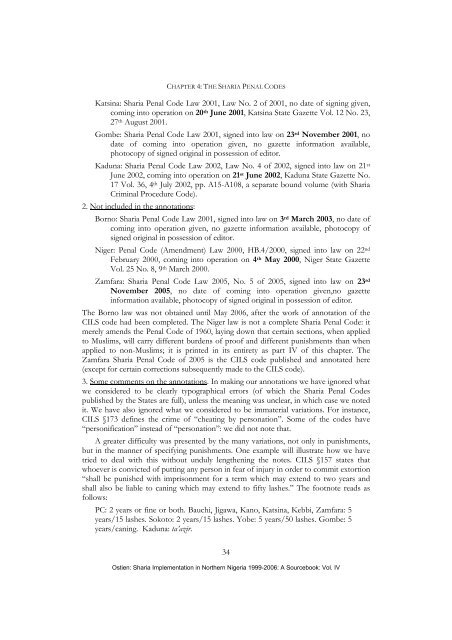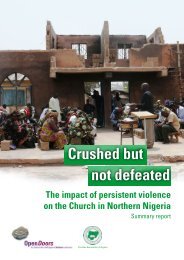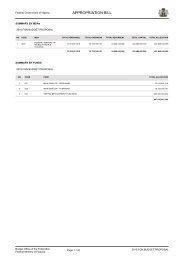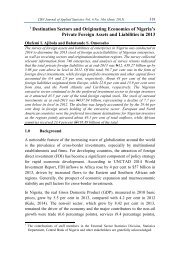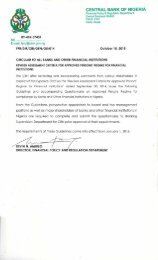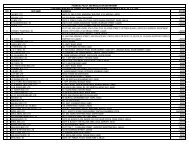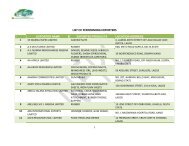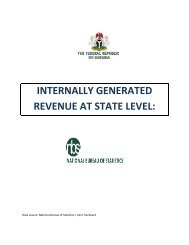vol_4_4_chapter_4_part_III
vol_4_4_chapter_4_part_III
vol_4_4_chapter_4_part_III
Create successful ePaper yourself
Turn your PDF publications into a flip-book with our unique Google optimized e-Paper software.
CHAPTER 4: THE SHARIA PENAL CODES<br />
Katsina: Sharia Penal Code Law 2001, Law No. 2 of 2001, no date of signing given,<br />
coming into operation on 20 th June 2001, Katsina State Gazette Vol. 12 No. 23,<br />
27 th August 2001.<br />
Gombe: Sharia Penal Code Law 2001, signed into law on 23 rd November 2001, no<br />
date of coming into operation given, no gazette information available,<br />
photocopy of signed original in possession of editor.<br />
Kaduna: Sharia Penal Code Law 2002, Law No. 4 of 2002, signed into law on 21 st<br />
June 2002, coming into operation on 21 st June 2002, Kaduna State Gazette No.<br />
17 Vol. 36, 4 th July 2002, pp. A15-A108, a separate bound <strong>vol</strong>ume (with Sharia<br />
Criminal Procedure Code).<br />
2. Not included in the annotations:<br />
Borno: Sharia Penal Code Law 2001, signed into law on 3 rd March 2003, no date of<br />
coming into operation given, no gazette information available, photocopy of<br />
signed original in possession of editor.<br />
Niger: Penal Code (Amendment) Law 2000, HB.4/2000, signed into law on 22 nd<br />
February 2000, coming into operation on 4 th May 2000, Niger State Gazette<br />
Vol. 25 No. 8, 9 th March 2000.<br />
Zamfara: Sharia Penal Code Law 2005, No. 5 of 2005, signed into law on 23 rd<br />
November 2005, no date of coming into operation given,no gazette<br />
information available, photocopy of signed original in possession of editor.<br />
The Borno law was not obtained until May 2006, after the work of annotation of the<br />
CILS code had been completed. The Niger law is not a complete Sharia Penal Code: it<br />
merely amends the Penal Code of 1960, laying down that certain sections, when applied<br />
to Muslims, will carry different burdens of proof and different punishments than when<br />
applied to non-Muslims; it is printed in its entirety as <strong>part</strong> IV of this <strong>chapter</strong>. The<br />
Zamfara Sharia Penal Code of 2005 is the CILS code published and annotated here<br />
(except for certain corrections subsequently made to the CILS code).<br />
3. Some comments on the annotations. In making our annotations we have ignored what<br />
we considered to be clearly typographical errors (of which the Sharia Penal Codes<br />
published by the States are full), unless the meaning was unclear, in which case we noted<br />
it. We have also ignored what we considered to be immaterial variations. For instance,<br />
CILS §173 defines the crime of “cheating by personation”. Some of the codes have<br />
“personification” instead of “personation”: we did not note that.<br />
A greater difficulty was presented by the many variations, not only in punishments,<br />
but in the manner of specifying punishments. One example will illustrate how we have<br />
tried to deal with this without unduly lengthening the notes. CILS §157 states that<br />
whoever is convicted of putting any person in fear of injury in order to commit extortion<br />
“shall be punished with imprisonment for a term which may extend to two years and<br />
shall also be liable to caning which may extend to fifty lashes.” The footnote reads as<br />
follows:<br />
PC: 2 years or fine or both. Bauchi, Jigawa, Kano, Katsina, Kebbi, Zamfara: 5<br />
years/15 lashes. Sokoto: 2 years/15 lashes. Yobe: 5 years/50 lashes. Gombe: 5<br />
years/caning. Kaduna: ta’azir.<br />
34


